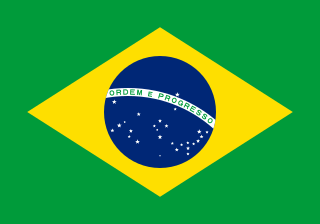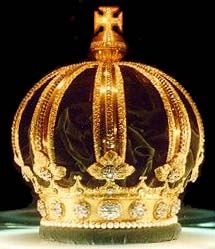 W
WOur Lady Aparecida - Our Lady Revealed - is a title of the Blessed Virgin Mary in the traditional form associated with the Immaculate Conception associated with a clay statue bearing the same title. The image is widely venerated by Brazilian Catholics, who consider her as the principal patroness of Brazil. Historical accounts state that the statue was originally found by three fishermen who miraculously caught many fish after invoking the Blessed Virgin Mary.
 W
WThe "Brazilian National Anthem" was composed by Francisco Manuel da Silva in 1831 and had been given at least two sets of unofficial lyrics before a 1922 decree by President Epitácio Pessoa gave the anthem its definitive, official lyrics, by Joaquim Osório Duque-Estrada, after several changes were made to his proposal, written in 1909.
 W
WThe coat of arms of Brazil was created on 19 November 1889, four days after Brazil became a republic. It consists of the central emblem surrounded by coffee and tobacco branches, which were important crops in Brazil at that time. In the blue circle in the center, the Southern Cross can be seen. The ring of 27 stars around it represents Brazil's 26 states and the Federal District.
 W
WCrux is a constellation in the Milky Way of the southern sky that is centred on four bright stars in a cross-shaped or kite-like asterism commonly known as the Southern Cross. The name Crux is Latin for cross. Even though it is the smallest of all 88 modern constellations, Crux is among the most easily distinguished as its four main stars each have an apparent visual magnitude brighter than +2.8. It has attained a high level of cultural significance in many Southern Hemisphere states and nations.
 W
WThe Efígie da República is used as a national personification, both in Brazil and in Portugal, symbolizing the Republic.
 W
WThe flag of Brazil, known in Portuguese as Verde e amarela, or less usually Auriverde, is a blue disc depicting a starry sky spanned by a curved band inscribed with the national motto "Ordem e Progresso", within a yellow rhombus, on a green field. Brazil officially adopted this design for its national flag on November 19, 1889 — four days after the Proclamation of the Republic, to replace the flag of the Empire of Brazil. The concept was the work of Raimundo Teixeira Mendes, with the collaboration of Miguel Lemos, Manuel Pereira Reis and Décio Villares.
 W
WThe Hino da Independência is a Brazilian official patriotic song commemorating the country's declaration of independence from Portugal. The anthem was composed in 1822 by Emperor Pedro I, the lead figure in the country's struggle for independence, and the lyrics were written by poet Evaristo da Veiga.
 W
WThe Imperial Crown of Brazil, also known as the Crown of Dom Pedro II or as the Diamantine Crown, is the Crown manufactured for the second Brazilian Emperor, Pedro II.
 W
WThe Imperial Regalia of Brazil consists of the Imperial Crowns: the Crown of Pedro II and the Crown of Pedro I; the Imperial Sceptre; the Imperial Orb; the Imperial Sword; and jewelry belonging to the Emperors and Empresses of Brazil. They were used until the abolition of the Brazilian monarchy in 1889. Most of the jewels have been displayed at the Imperial Museum of Brazil in Petrópolis and at the National Museum of Brazil in Rio de Janeiro since 1943. Other items are stored at the National Treasury in Brasília.
 W
WThe National Seal of Brazil is one of Brazil's national symbols, displayed on several official documents, such as graduation diplomas, consular and diplomatic papers, military conscription forms, etc. Most documents, however, feature the National Coat of Arms instead of the National Seal.